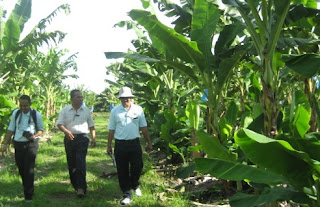Friday, March 31, 2017
STUDY ON BANANA CULTIVAR IN MALAYSIA
BANANA (Musa paradisaca) are among popular fruit grown in Malaysia. The Department of Agricullture reported about 30,320 hectare of banana were grown in 2016 producing estimated o 310,320 metric tonnes of fresh fruits. Recently an efforts are underway to revive our low number of fruit cultivars by Research Agencies in Malaysia. If we visit any night market, fruit shop or supermarket and chances are you will find very few varieties of bananas being sold. For a crop that has been cultivated since ancient times in Malaysia (reputedly its place of origin), the lack of choice is surprising. A myriad of local species used to be available, but not anymore. A random check at two hypermarkets revealed only two choices: the imported Cavendish and the local pisang berangan. The future scenario appears bleak for our local banana cultivars, which are not only up against foreign competition - in the form of the hardy and unblemished Cavendish - but also against other more profitable and productive crops. The problem is not just confined to bananas. Other fruits like pineapples and mangoes, too, suffer from dwindling varieties. As farmers focus on growing only the best breeds for maximum yield, the challenge lies in the hands of the Malaysian Agricultural Research And Development Institute (Mardi) to stimulate research and conservation work to sustain diversity of these crops, and to ensure that a wealth of genetic resources exist for breeding quality and high-performing varieties.
In Malaysia, banana varieties like berangan, mas, rastali and Cavendish are used in cookery while nipah, nangka, tanduk and pisang awak are used in desserts. These edible cultivars are derived from two wild species, Musa acuminata Colla and Musa balbisiana Colla. (The Musa acuminata is reportedly the most variable species and progenitor of cultivated bananas.) The commercial success of Cavendish, which dominates supermarket shelves, has a lot to do with promotion. For a fruit to do well, he says it has to meet consumers’ expectations and acceptance - the fruit must not just look good but taste good. The fruit’s features are as important as the quality, which means that for us to be competitive, we need to research and extract value-added properties like possible medicinal values. After that, we look into the yield, or how easy it is to plant and harvest, before domesticating it and planting it commercially. The technology to screen for genes responsible for certain elements or quality, as well as for pest- and disease-resistant traits. We also have a seed unit that produces high quality foundation seeds and planting materials for our research programmes.”
The production sites are located at Mardi stations in Serdang, Sintok (Kedah), Kuala Kangsar (Perak), Jerangau (Terengganu), Jelebu (Negri Sembilan), Kelang (Selangor) and Bintulu (Sarawak). In the case of mangoes, the Department of Agriculture has registered 77 varieties and 209 clones to date, though only a few clones are popular for commercial planting - chokanan, harum manis, golek, maha and mas muda. The common mango, Mangifera indica, is the only widely cultivated species, though there are several other lesser-known species like the Mangifera odorata (kuini), Mangifera foetida (bacang) and Mangifera caesia (binjai). This article was adapted from news paper about banana. Thanks.
By,
M Anem,
Senior Agronomist,
Serdang Agriculture Station,
Selangor, Malaysia.
(Febuary 2017)
Subscribe to:
Post Comments (Atom)



No comments:
Post a Comment